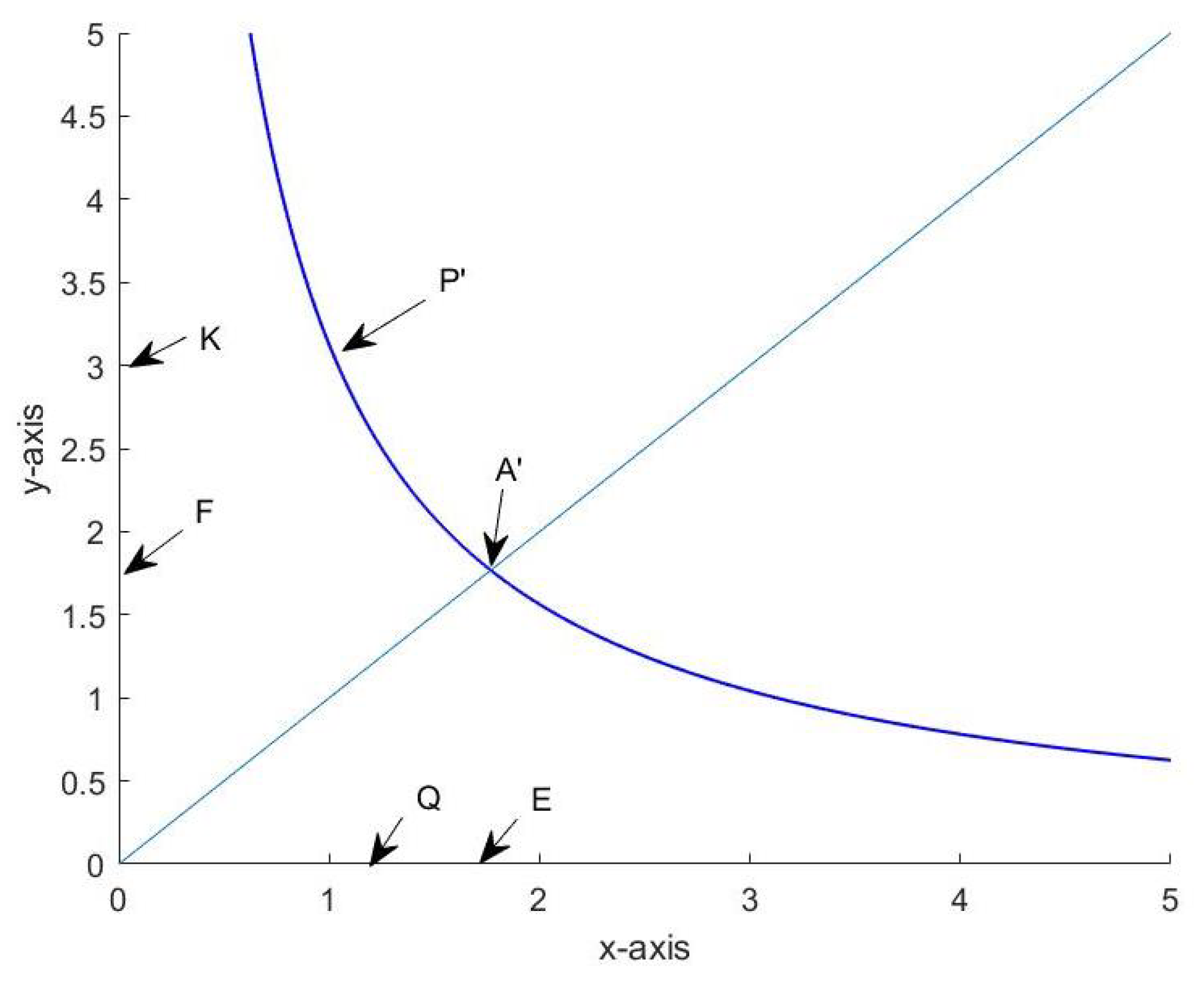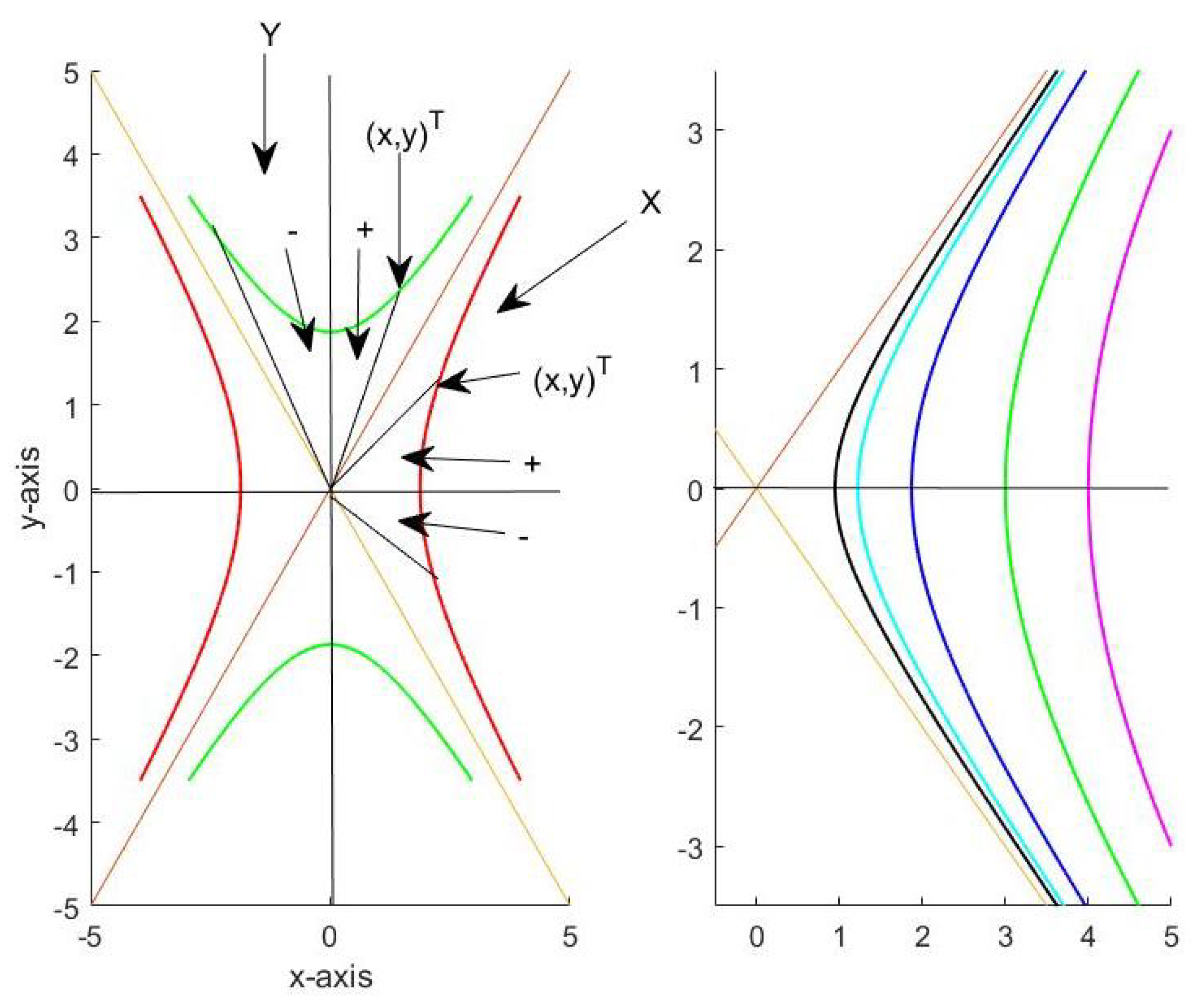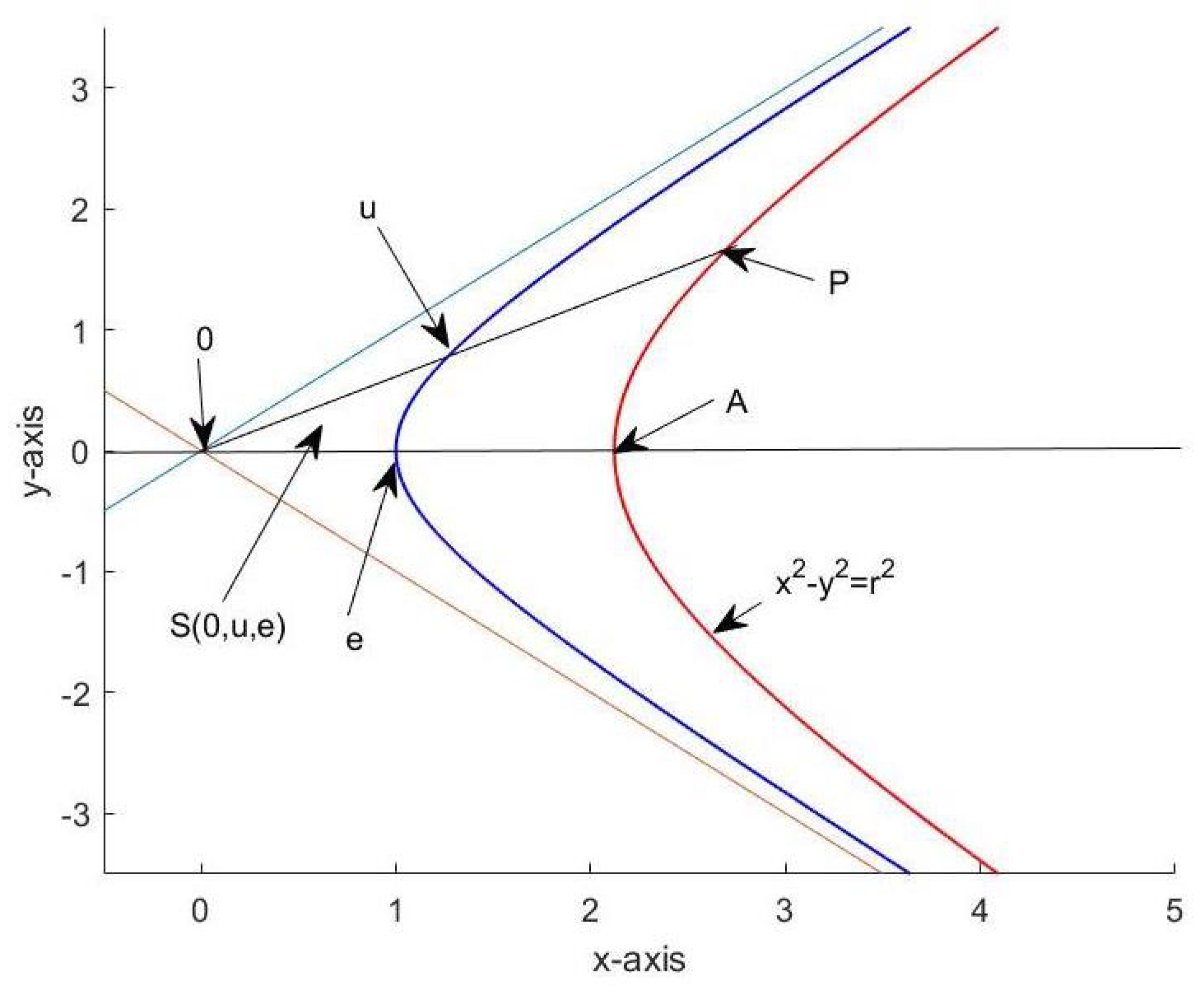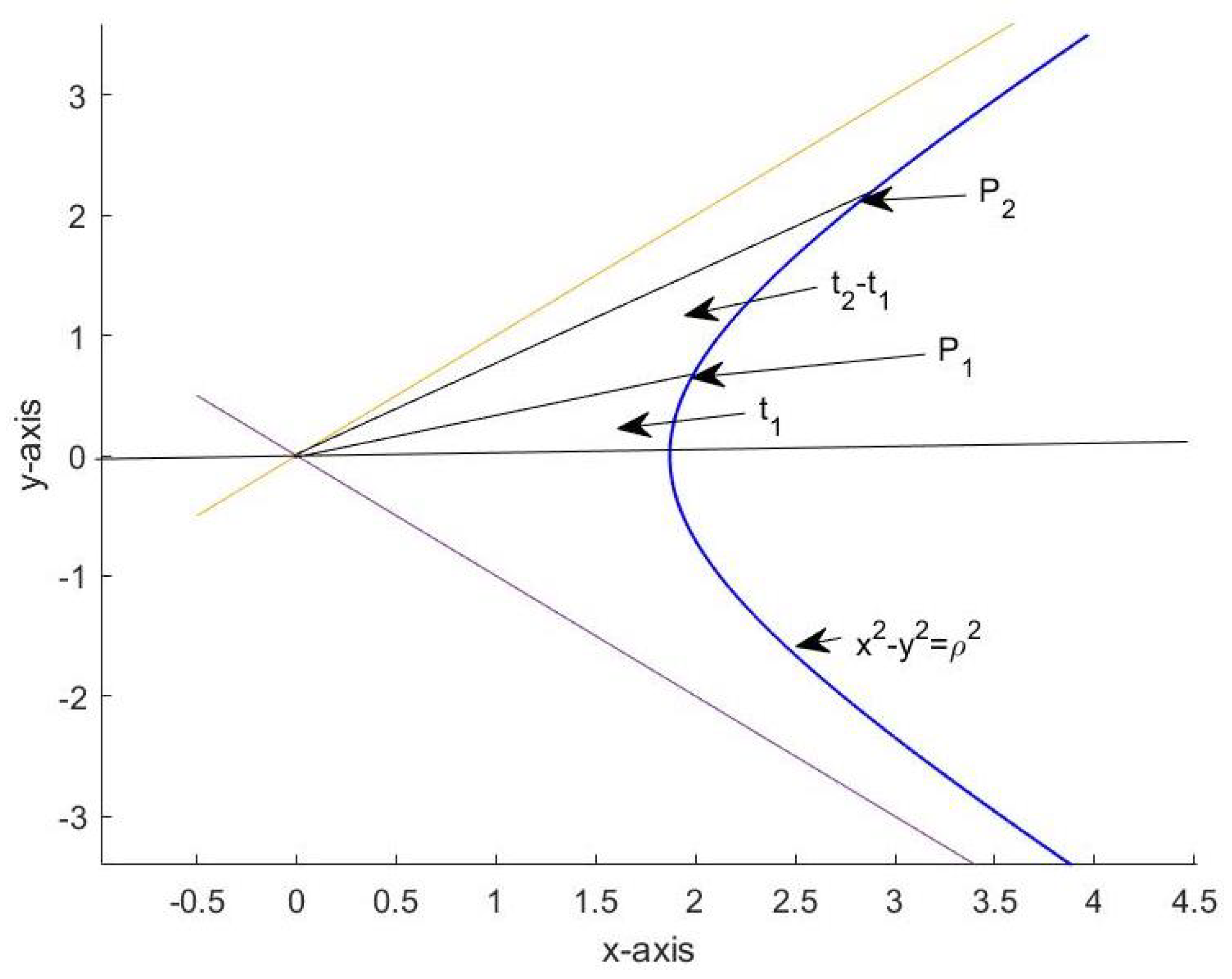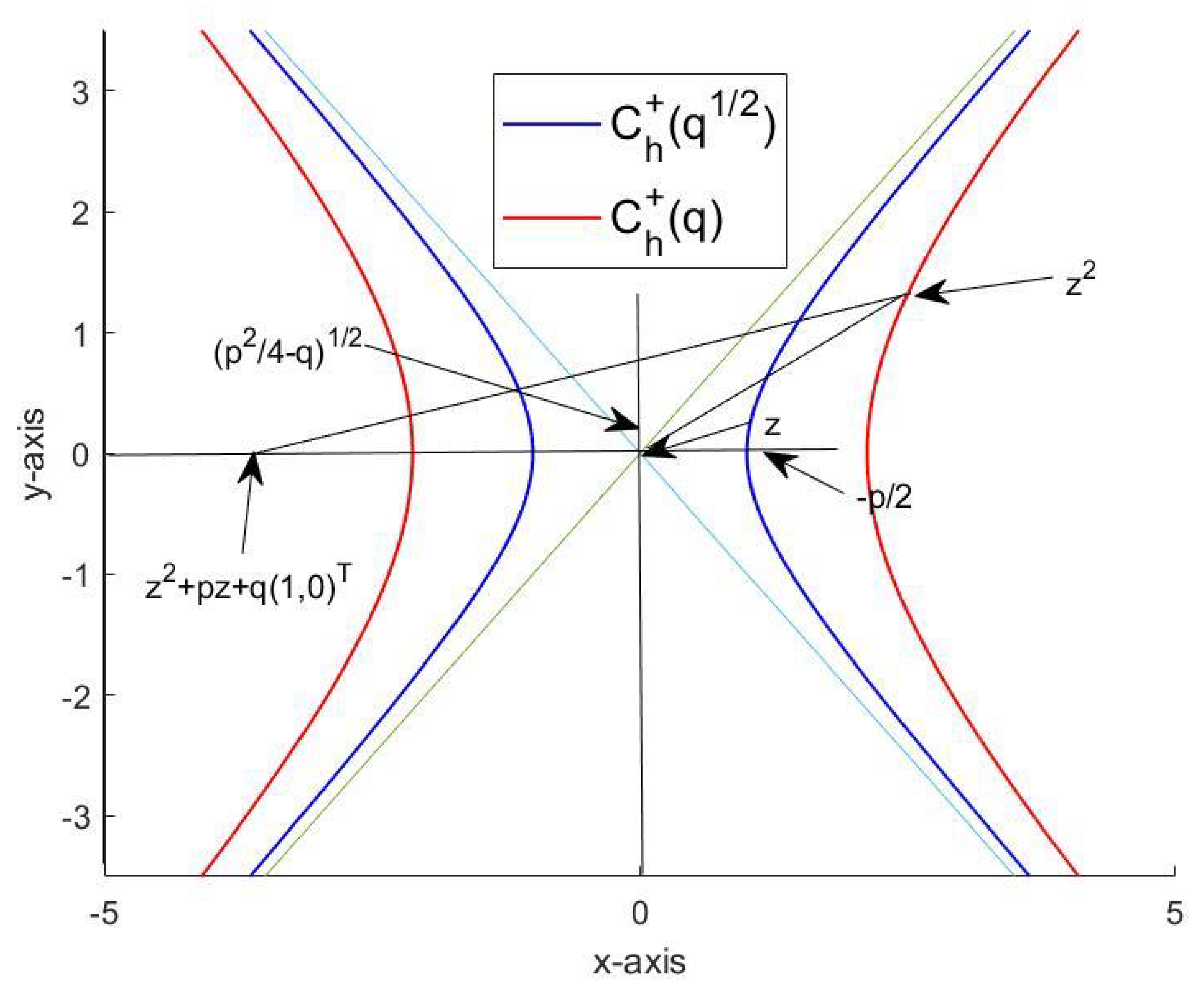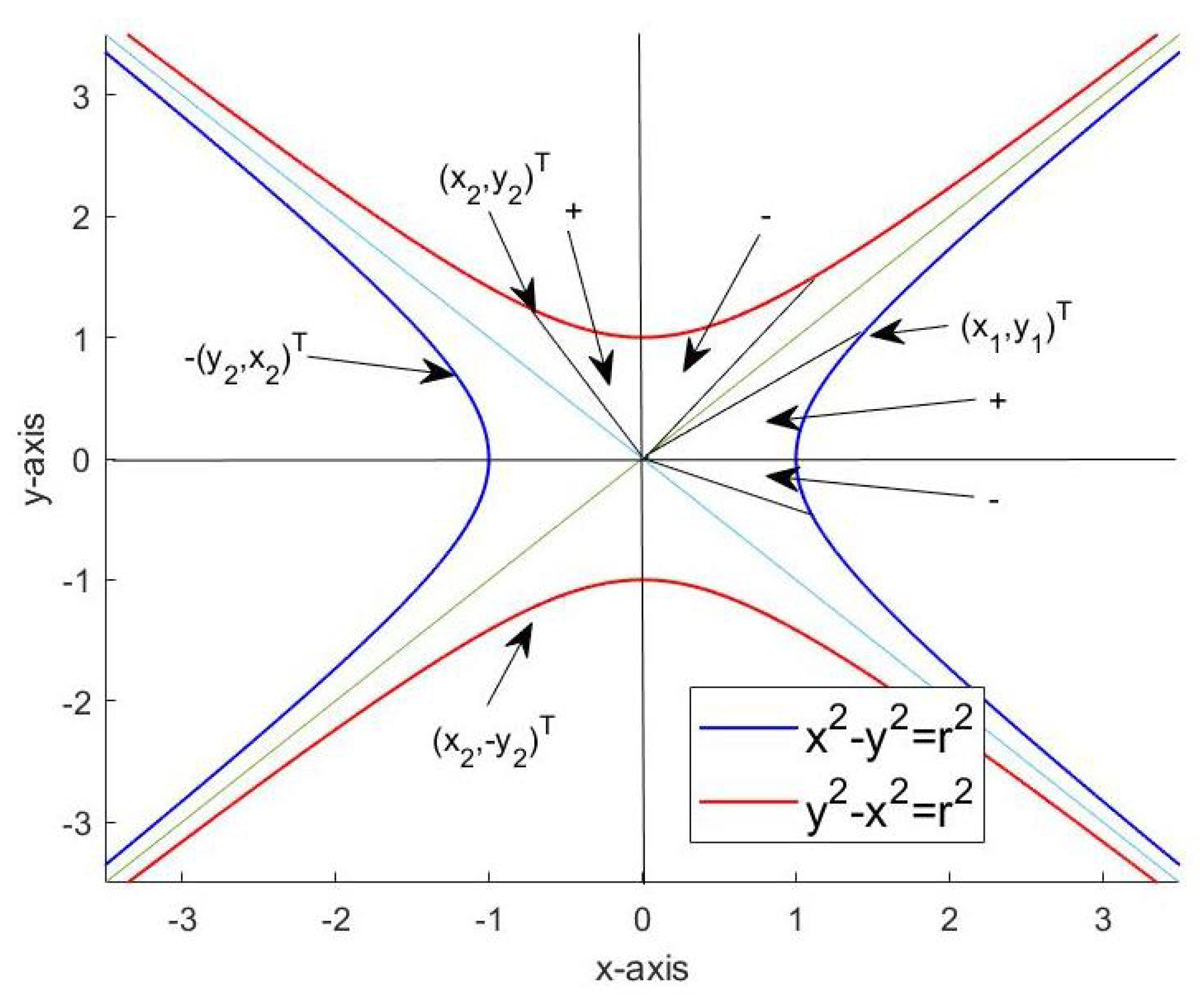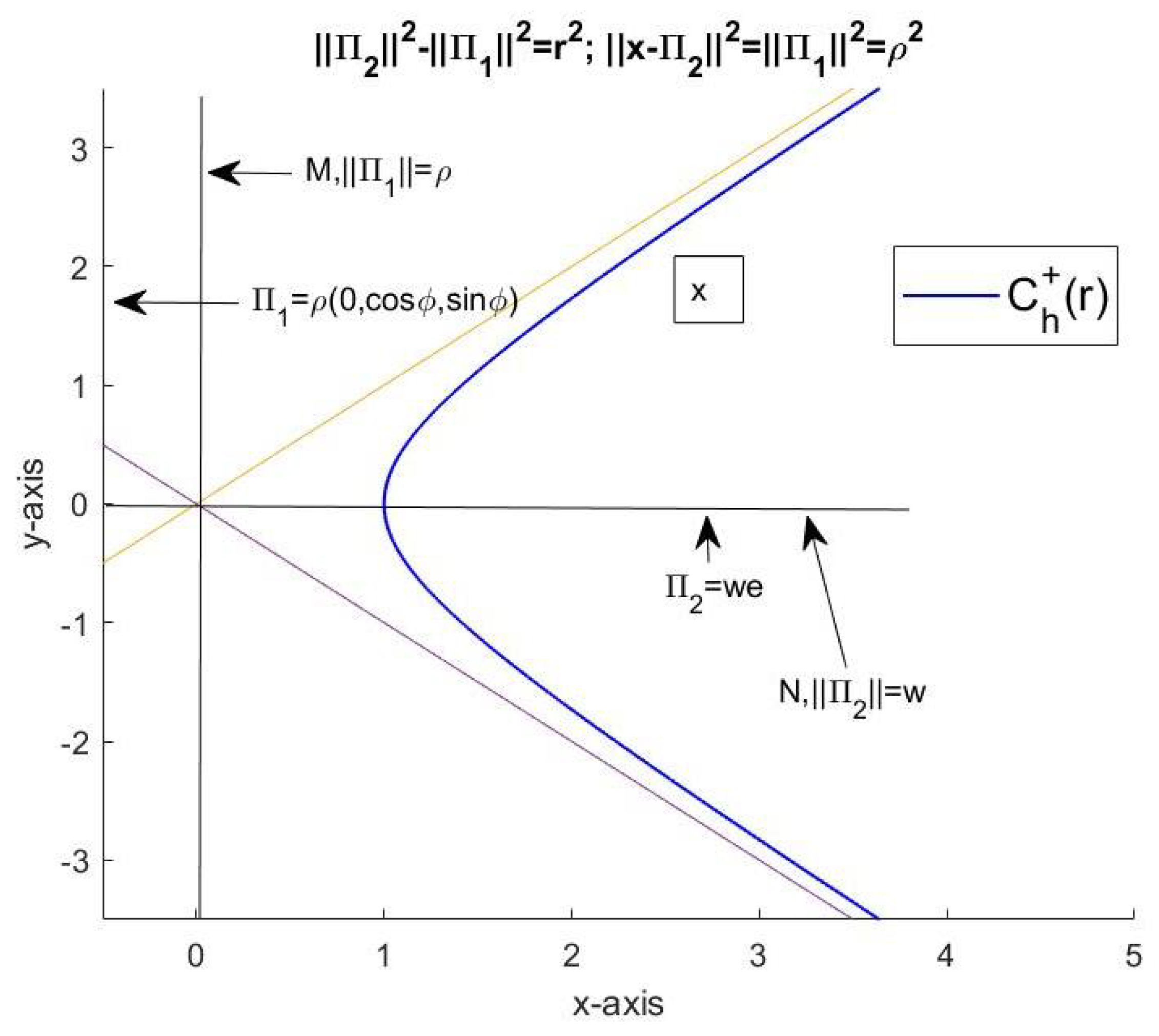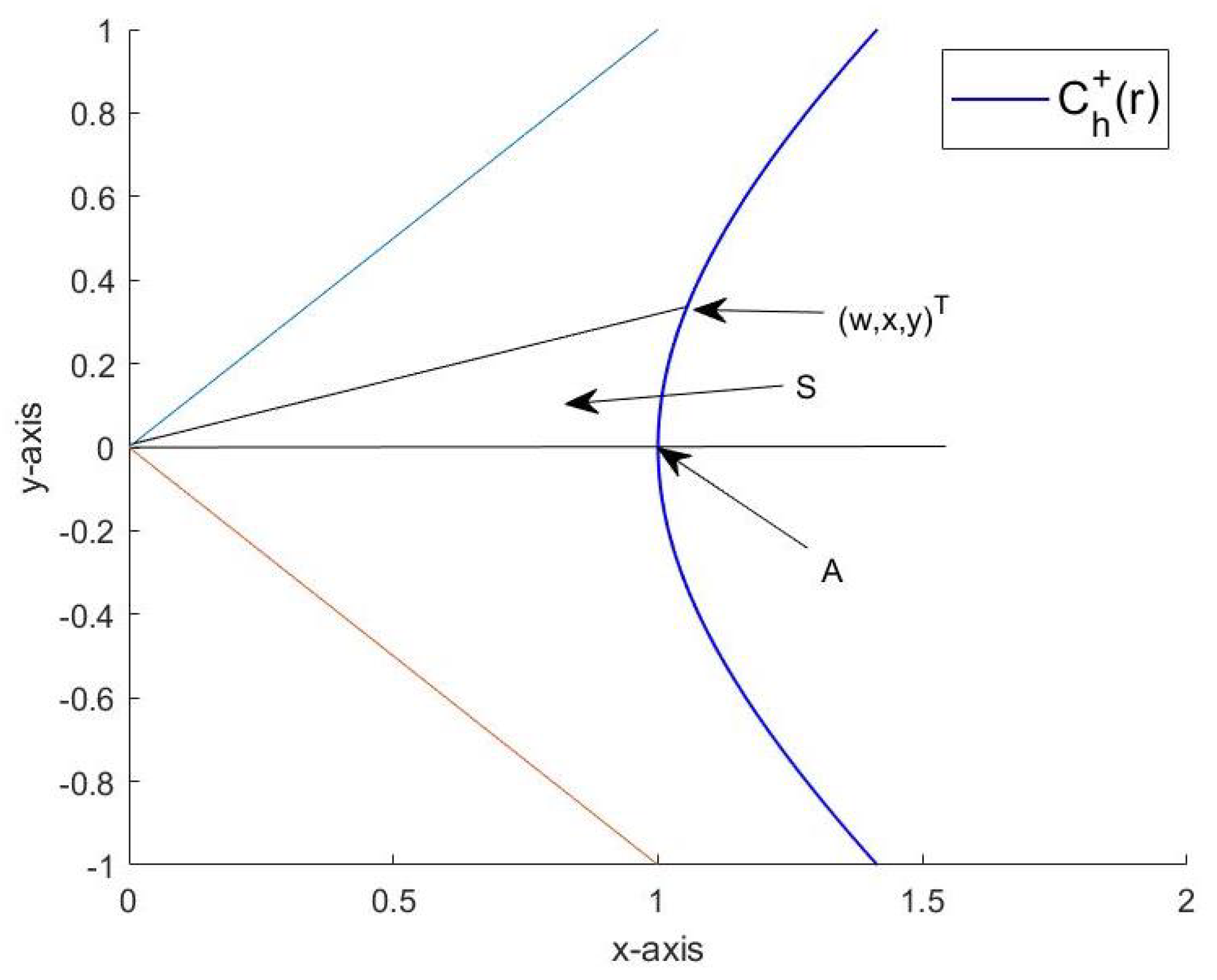1. Introduction
QED. These three letters are often found at the end of a mathematical proof or even an entire mathematical paper, but what meaning can they have at the beginning of a work, this work? It is the great historical importance that quantum electrodynamics has for the application of complex numbers and vector multiplication outside mathematics. In [
1], this connection is presented in a very impressive way for a broad readership. Arrow combination and in particular multiplication form the technical basis there for the mathematical treatment of physical phenomena such as reflection and diffraction and many others. The interactive computer animation programs in [
2] make it possible to simulate such physical phenomena on the computer in a fascinating way. The reader is invited to create similar animation programs based on the present mathematical results. For an application of vector multiplication when using photo manipulation programs, we refer to [
3].
If complex numbers are not adequate to describe certain mechanical [
4], or other physical [
5,
6,
7] or technical [
8] processes then their generalizations or modifications may be of interest. Hyperbolic complex numbers which are usually represented as
are strictly related to space-time geometry of two dimensional special relativity [
9,
10,
11]. Here,
is understood as an abstract or independent quantity taken from somewhere else outside of
Hyperbolic complex numbers were developed in [
10,
12,
13,
14,
15] and are also known by several other names, such as, e.g., perplex numbers [
9], split complex numbers [
5,
9,
16,
17], space-time numbers [
18], dual numbers [
6], double numbers [
8,
10] as well as twocomplex numbers [
19], to name just a selection of the numerous possible references.
In this context, the hyperbolic exponential function is defined in [
9,
15,
20] for
by
where
and the hyperbolic rotation of an angle
transforms a vector
in the new vector
The quantity
is invariant with respect to hyperbolic rotation.
The generalized complex multiplication discussed in [
11] includes the ordinary product
the Study product
and the Clifford product
as particular cases. A somewhat different approach to hyperbolic complex numbers is provided in [
21] by the use of so called jay-vectors,
Does it make things easier to answer the questions of the existence and possible uniqueness of the abstract or formal quantities and operations encountered when having two non-identical approaches, (
1) and (
4), to the hyperbolic complex unit? How about the true character of this unit? Mathematical quantities are usually defined by positively stating their properties instead of excluding certain properties, as is the case with “
”.
Some new aspects concerning existence and (non-)uniqueness of usual complex numbers as realizations of a general algebraic structure are derived in [
22,
23,
24,
25]. There is only briefly mentioned here a property that stands in a certain connection with [
1]. There certain probabilities are calculated as length squares of sums of two vectors. If parallel vectors of length 0.2 are oriented in the same direction or in opposite directions, the results are 0.16 and zero, respectively. However, if two such vectors are perpendicular to each other, the value 0.08 results according to the Pythagorean theorem. In [
1], reference was made to the fascinating fact that these probabilities are experimentally verified with extremely high accuracy. If one is only interested in obtaining the above three results, any of the vector multiplications from [
22] can be used, which might be of some interest for further considerations of physical or other phenomena.
In the present paper, we follow as closely as possible the way taken in [
22,
23,
24,
25]. As a result, it becomes possible to generalize hyperbolic complex numbers into different directions. Here, we present multivariate generalizations. We further develop the historically close connection between complex analysis and vector algebra by defining a hyperbolic exponential function using a suitable definition of vector product and power for the definition of the exponential function through a series expansion. While in [
22] a vector product based on the ordinary product was introduced, here, to correspondent to Definition 6 of a geometrical hyperbolic vector product, we will introduce a vector product based on the Clifford product.
The paper is organized as follows. We start in
Section 2.1,
Section 2.2 and
Section 2.3 by introducing a hyperbolic vector product, which allows the subsequent introduction of hyperbolic vector powers and a hyperbolic vector exponential function. The latter, as well as the hyperbolic rotation, will therefore be introduced differently than in (
2) and (
3). In
Section 2.4 and
Section 2.5, we discuss a quadratic vector equation and modified Cauchy–Riemann differential equations. The slightly modified hyperbolic complex algebraic structure considered in
Section 2.6 is based upon a vector product that is a geometrically motivated modification of the vector product being related to the Clifford product. In
Section 3, we treat space-time or spherical-hyperbolic complex numbers in dimensions three and four. We close with a discussion in
Section 4 and Appendices
Appendix A and
Appendix B.
We leave it to the reader to choose other basis elements of the underlying event spaces than those chosen here. In [
23], it was discussed in detail that changing the basis elements of an event space does not affect the basic properties of the complex algebraic structures considered there. This also applies here.
2. The Basic Hyperbolic Complex Algebraic Structure
2.1. Vector Algebra
Let
denote an event space, that is the set of possible outcomes of an experiment or the light cone in the physical interpretation or just a set of possible observations of interest on which multiplication with positive real numbers is defined to be the function
where
.
Definition 1. The vector addition is defined componentwise asIf there exists such that , then we say that can be subtracted from or is additively reachable from or event influences event . In this case, we writeand call the operation the operation of constrained vector subtraction. Let
and assume that vector addition and constrained vector subtraction are defined analogously on
Definition 2. The analytical hyperbolic vector product of and is defined aswhereThe k’th hyperbolic vector power of and the hyperbolic vector exponential of z are defined byandrespectively. We emphasize that we exclusively use the product
for defining the hyperbolic exponential of
z. For our motivation for doing so, we refer to Remark 2 below. Vector product and exponential can also be understood as arrow product and exponential in the sense of [
1].
Definition 3. The analytical hyperbolic vector product of and is defined to be a random variable on an abstract probability space that takes the values and accordingly with probabilities and .
Notice that
If you look at Definitions 2 and 3 together, the hyperbolic vector product is a function
Because the focus of our consideration is
, we do not consider
on combinations of
and
.
Example 1. The vector is the additive neutral element. Let If thenThat is, within is the multiplicative neutral element. On the other hand, if thenHere is the result of reflecting the point at the line Definition 4. If for and from there exists such that , then we say that can be divided by and call the operation the operation of constrained vector division. If can be divided by , then we call the inverse of z.
Notice that if
has an inverse, then
The vector product
is obviously commutative and the second up to the fourth hyperbolic vector powers of
are
and
respectively.
2.2. Geometry
Let us call
a hyperbolic circle of hyperbolic radius
and
its
-sector in short, see
Figure 1.
If and , then . The Lie group on is thus generated by the multiplications with the elements from the unit half-circle In other words, if the function is defined by , then multiplication of by any leaves invariant.
Definition 5. The hyperbolic coordinate transformation , , is accordingly defined asHere, the notation indicates whether the signed area content ψ is measured counterclockwise between and or clockwise between and see Figure 2. The union of all
-sectors
represents a disjoint decomposition of the cone
, see
Figure 2.
The transformation
therefore has an a.e. uniquely determined inverse
, which is given by
with
Remark 1. With the quantity equals two times the signed area content of the hyperbolic sector the boundary of which is marked with the help of the points and see Figure 3. For an elementary geometric proof of this remark, we refer to
Appendix A.
Definition 6. The geometrical hyperbolic vector product of and being both either from or from is defined as The expression on the right side of the last equation is always uniquely defined because due to Remark 1 the sum
represents the finite content of a bounded hyperbolic sector (triangle), which itself is a subset of an unbounded set having infinite area content, see
Figure 4.
Let
and let
denote a hyperbolic sector (or hyperbolic triangle) spanned by the points
see
Figure 5. Additionally, let
be a transformation defined by
Then,
Theorem 1. The transformation is area-preserving.
Proof. We show that
does not change the content of a hyperbolic sector. The area content of such sector
is
□
If and , then the geometrical hyperbolic vector multiplication may be reflected by sector combinations of two types. Since there is no a priori preferred variant for one of two possibilities of assigning the sum of signed area contents, they can be regarded as occurring randomly. The following definition may thus be considered being well motivated.
Definition 7. The geometrical hyperbolic vector product of and is defined to be a random variable on an abstract probability space, which takes the values and accordingly with probabilities and .
Theorem 2. The geometrical and analytical hyperbolic vector products are equal.
Proof. If
then by (
8),
It follows from this and the definitions of the hyperbolic functions that
If
or
and
then the proof follows analogously. □
2.3. Complex Analysis
A classical way to introduce complex numbers is to say that they allow the representation
where
x and
y are real numbers and
is a formal quantity coming from somewhere other than
and satisfying
. The reader of such a definition is then tacitly asked to believe that the quantity
exists in the sense that it can be assigned a strict mathematical meaning and that the operation of squaring this “imaginary unit” agrees or harmonizes with the operation usual in the realm of real numbers. The reader is also left alone with thinking about the possible uniqueness of such a quantity. The answer to this challenge can vary. One can try to take
for a vector or a matrix and in each case define a corresponding multiplication rule. However, the usual squaring of vectors and matrixes does not result in the number −1. Therefore people in usual complex number theory sometimes say that they “identify” the vector
with the real number
, without saying, however, what an “identification” is other than an equation. However, obviously
does not equal −1. In [
26], it is alternatively discussed that a complex number has a dual real value nature, i.e., is capable of two values without being able, however, to fully explain it. We recall that Definition 3 of the present work gives a well motivated explicit definition of a two-valued random hyperbolic vector product.
In [
22,
23,
24,
25], algebraic structures are introduced, within which the “imaginary unit” is always explicitly given as a well-defined element from the vector space underlying this structure. Here, we follow this approach as closely as possible and therefore necessarily extend the event space. Just as the imaginary unit
does not belong to the real line
if one describes complex solutions of quadratic equations over
see
Section 2.4 and [
24], the vector
obviously does not belong to the originally considered event space
but belongs to the set
. Note that
and
Remark 2. If one follows usual hyperbolic number notation and writesinstead of (9), then one is tacitly using the multiplication rule, which is well motivated for elements of for the element of . This motivates our definition of the hyperbolic exponential in Definition 2. The hyperbolic vector exponential of allows a representation that is reminiscent of Euler’s well-known trigonometric representation of usual complex numbers, where, however, the so called imaginary unit is replaced with vector and the trigonometric functions sine and cosine are replaced with hyperbolic functions.
Theorem 3. The following hyperbolic Euler-type formula holds true: Proof. The rearrangement of the infinite vector sum
is allowed due to its convergence properties. Finally, the definitions of the hyperbolic functions apply. □
Note that belongs to the observation set , but comes from a well-defined other set and the hyperbolic vector multiplication rule is explained in the extended event space. In contrast to the classical approach to complex numbers, however, is explicitly known, here. The following definition is now well motivated.
Definition 8. We call a hyperbolic complex algebraic structure with and being the additive and multiplicative neutral elements and the hyperbolic element satisfying (9). We recall from [
23] that changing the basis elements of an event space may be very useful and does not affect the basic properties of the complex algebraic structure.
2.4. Solving a Quadratic Vector Equation
If
, then the quadratic equation
has the real solutions
. The structure of these solutions reproduces if one considers the quadratic vector equation
or
The result
is graphically illustrated in
Figure 6. For a closely related geometric discussion of quadratic vector equations with respect to
-vector multiplication, we refer to [
24].
2.5. Hyperbolically Modified Cauchy-Riemann Differential Equations
Let
According to Definition 4, we call
hyperbolic multiplicative reachable from
if there exists
such that
. If this is so, then we call
the hyperbolic ratio of
and
and write this as
One can check that
and in particular
If we apply (
13) also for
and
, then
While
means the identity mapping, the mapping
means reflection of the point
at the line
.
Let
D be an open subset of
. A function
is called hyperbolically differentiable in
if the ratio
converges to a limit point
, say, as
, that is
The function
f will be called hyperbolically holomorphic in
D if it is differentiable in every
from
D. If such function is given by
then it follows that hyperbolic modifications of the well known Cauchy–Riemann differential equations hold. To become more specific, we consider points
with
Letting now the values of
h tending to zero, and, respectively, denoting the partial derivatives with respect to
x or
y of a function
by
and
, we get
where
is a certain number from the interval
. Similarly,
The following theorem has thus been proved.
Theorem 4. The hyperbolically holomorphic function , satisfies the hyperbolically modified Cauchy–Riemann partial differential equations Consequently, hyperbolically holomorphic functions
have the property
2.6. A Slightly Modified Hyperbolic Complex Algebraic Structure
Let us assume that the definition of the hyperbolic coordinate transformation
is changed so that now the signed area content
is measured counterclockwise between
and
, see
Figure 7. Then, slightly different from Definition 5, it follows that
For the geometric definition of the hyperbolic vector product, it then results that, in
,
Overall, the analytical and geometric definitions of the hyperbolic vector product are then
and in
,
The result is a modified hyperbolic complex algebraic structure
where if
and still
then
and if
then
Here,
is the result of rotating
counterclockwise by
.
4. Discussion
Why do we allow applying the rule in (
5) to the extended event space when it is originally defined only for pairs of elements of either
or
? To approach an answer, let us first recall the situation with usual complex numbers as described at the beginning of
Section 2.3. Since there is certainly no explanation for
as a “number”, there is no explanation for
in this approach.
However, for centuries, successful applications of complex numbers have provided the motivation to deal with them, even though there is a certain lack of mathematical rigor in their definition. Practical success in using imaginary numbers was taken as proof of their existence, which is rather untypical for pure mathematics. The strict approaches in [
22,
23,
24,
25] have overcome this deficit for the usual complex numbers and their certain generalizations by giving explicit vectorial definitions of the imaginary unit.
The meaning of complex numbers has evolved over a historically lengthy process. While complex numbers initially played a formal role in solving quadratic equations, they later became an indispensable tool in many applied sciences, e.g., in electrical engineering where the current
I and voltage
U in an alternating current circuit satisfy the equation
in time
t. In the event that other quantities
and
satisfy the equation
,
p-generalized complex numbers were introduced in [
22]. Higher dimensional and other generalizations were considered in [
23,
24,
25].
In two-dimensional space-time models, quantities
X and
T that satisfy the equation
are of interest. In such a case, ordinary complex numbers do not provide an adequate description, but hyperbolic complex numbers. Such numbers, together with their multidimensional generalizations, have been introduced in the present work. This could pave the way for numerous potential applications of generalized complex analysis. Just as the existence of a verifiable usual imaginary unit was unclear for a long time, so was for the hyperbolic imaginary unit. This gap was closed in the present work and concrete vector representations for the hyperbolic imaginary unit were given. Since the properties of each vector are essentially determined by the properties of the space containing it, the choice of a vector space is of great importance when processing a specific application. In particular, it is of great importance to empirically verify the validity of a vector multiplication or arrow combination in the respective application and to develop corresponding computer animation programs as was mentioned in the Introduction for the QED. A hopefully broad readership from different application areas is invited to follow this path. The creation of interactive computer animation programs in the sense of [
2] but for vector multiplication as in the present work can be a building block of such a project.
